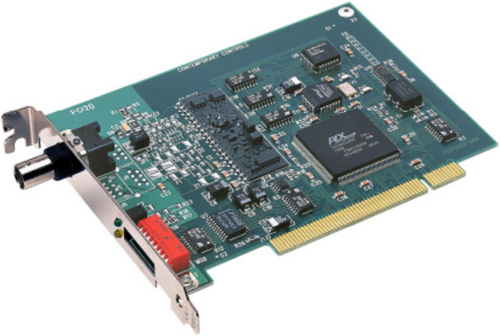ARCNET PCI20 Series Legacy Product

Product Overview
|
|
More Information
The PCI20 Series of network interface modules (NIMs) interfaces ARCNET with PCI bus computers. The high performance PCI bus allows for jumperless configuration or plug and play operation.
The PCI20 incorporates the newer COM20020 ARCNET controller chip with enhanced features over the earlier generation ARCNET chips. New performance and integration enhancements include command chaining operation and an internal 2K x 8 RAM buffer. There is no requirement for wait-state arbitration.
Each PCI20 module has two LEDs on the board. The green LED indicates that the module is transmitting data on the network and the yellow LED indicates bus access to the module. The PCI20 also has an external DIP switch so that node addresses can be easily reassigned without removing the module.
Several versions of the PCI20 ARCNET NIM exist. The PCI20-CXS supports coaxial star configurations requiring external active or passive hubs. The PCI20-CXB supports coaxial bus configuration usually requiring no hubs. Other models include the PCI20-FOG which supports fiber optic cable with either ST or SMA connectors. The PCI20-TB5 supports twisted-pair bus cabling using RJ-45 connectors. There are some versions that support EIA-485 communication each using RJ-45 and screw terminal connectors.
Replacement Information
In almost all cases, a PCI20 NIM can be easily replaced with a PCI20U NIM. The PCI20U uses the COM20022 ARCNET controller chip which is backward compatible with the COM20020 chip that was used on the PCI20s. Therefore, you will experience no software issues as a result of substitution because your software will not be able to distinguish between the two devices. There are, however, physical differences between the two products and these differences (usually of minor or no significance) are explained below.
The PCI20U was made smaller than the PCI20 so that the newer card could fit into a miniature computer case. The smaller size results in three issues that may be of concern to some users:
- Because the PCI20U is smaller, its mounting bracket does not have enough space for redundant fieldbus connectors. Therefore, PCI20U models have no RJ-45 jacks-but continue to offer screw connectors for securing twisted-pair cabling.
- Also, the smaller PCI20U size has resulted in the DIP switch being moved from the bracket to another location on the card. This means that, for those who use the switch, post-installation access to the switch can only be accomplished by opening the case of the equipment into which the PCI20U has been inserted.
- When the DIP switch was relocated on the PCI20U, it was necessary to redefine which end of the switch carried the Least-Significant-Bit (LSB) and which end held the Most-Signifciant-Bit (MSB). As a result, if you use the DIP switch for setting the ARCNET node ID, you cannot simply emulate your old DIP switch settings. Instead, you will need to set the 8 individual switch poles to their complementary positions as explained in the PCI20U Installation Guide. If your ARCNET node ID value is set by software, this will not be an issue.
The PCI20-FOG-SMA and the PCI20-FOG-ST have no direct substitutes. If you need fiber connectivity for a PCI ARCNET NIM, you should use an AI Series hub for the media conversion.
The PCI20U comes pre-attached to a standard (large-height) bracket for convenient installation in a traditionally sized computer case. However, a smaller bracket provided with the card can be used in place of the standard-height bracket.